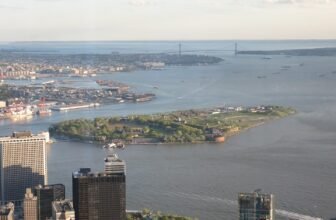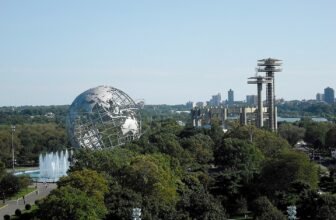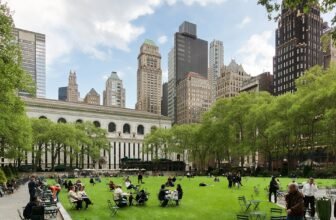
Prospect Park, Brooklyn: The Soul of the Borough
When people think of New York City parks, Central Park often steals the spotlight. But tucked in the heart of Brooklyn lies a lush, sprawling green space that many consider the city’s true hidden gem: Prospect Park. Created as the borough’s answer to Manhattan’s iconic park, Prospect Park has grown into much more than just a rival , it’s a sanctuary, a cultural hub, and a beloved backyard for millions of Brooklynites.
But is Prospect Park worth visiting? What can you do there? Can you walk in it, and how does it compare to Central Park? Let’s journey into the heart of Brooklyn and find out.
A Park with Purpose: The Origins of Prospect Park
Before diving into the experiences Prospect Park offers today, it’s worth exploring how it came to be.
Designed by the legendary landscape architects Frederick Law Olmsted and Calvert Vaux , the same duo behind Central Park , Prospect Park opened in 1867 as a response to Brooklyn’s growing need for green space. Olmsted and Vaux believed their Prospect Park design was their true masterpiece, even superior to Central Park, because they were able to implement all the lessons they had learned.
Unlike Central Park, which had to weave around a grid system and existing infrastructure, Prospect Park was a blank slate. The designers used the natural topography of the land to their advantage, creating a 700-acre oasis that seamlessly blends forests, meadows, and waterways.
Is Prospect Park Worth Visiting?
In a word: Absolutely.
Prospect Park is more than just a park , it’s a community cornerstone that offers something for everyone. Whether you’re a tourist looking to escape the city’s noise or a Brooklyn local needing a nature fix, the park never disappoints.
Why Prospect Park Is Worth It:
-
Diverse Landscapes: It’s rare to find a place where you can walk through dense woodland, relax in open meadows, and canoe across a tranquil lake , all within a few hundred yards.
-
Free Cultural Experiences: From outdoor concerts at the Bandshell to impromptu drum circles near the Long Meadow, the park is a cultural playground.
-
Family-Friendly Attractions: Prospect Park Zoo, the LeFrak Center, and the Carousel make it a paradise for kids.
-
Wildlife and Nature: Birdwatchers, nature photographers, and horticulture lovers will find a treasure trove here.
What to Do in Prospect Park, Brooklyn
There’s a magic in walking into Prospect Park , a sense that you’re about to stumble upon something new. Here’s a breakdown of the best things to do in this sprawling urban escape:
1. Stroll Through the Long Meadow
The Long Meadow is one of the longest uninterrupted stretches of meadowland in any U.S. urban park , nearly a mile long. On any sunny afternoon, you’ll find people picnicking, playing soccer, tossing frisbees, or just lying in the grass with a book.
It’s the perfect place to start your visit , a gentle welcome into the park’s embrace.
2. Wander in the Ravine and the Vale of Cashmere
This isn’t your typical city park woodland. The Ravine, also called Brooklyn’s last forest, is a winding network of trails, waterfalls, and rustic bridges that feel like you’re miles away from any metropolis. It’s part of the Woodland Restoration Project, which has brought native species back and created a thriving ecosystem.
Nearby, the Vale of Cashmere , once a neglected area , has been restored into a quiet sanctuary with ornamental ponds and rare plant life.
3. Explore the Prospect Park Zoo
For families and animal lovers, the Prospect Park Zoo is a must. It’s not massive, but it’s packed with character. You’ll find red pandas, sea lions, Pallas’s cats, and even a discovery trail where kids can interact with farm animals.
Admission is affordable, and it’s perfect for spending a couple of relaxed hours with younger children.
4. Glide at the LeFrak Center at Lakeside
Winter or summer, the LeFrak Center offers activities that are both exhilarating and serene. During the winter months, the center transforms into an ice-skating rink. In the warmer seasons, it’s home to roller skating, boating, biking, and splash pads for kids.
It’s also a beautiful example of modern architecture complementing natural design.
5. Relax by Prospect Park Lake
The 60-acre lake at the southern end of the park is the largest in Brooklyn. You can rent pedal boats and kayaks, go fishing (catch and release only), or simply sit along the edge with a coffee in hand and admire the reflections.
It’s also a birdwatching hotspot. Egrets, herons, swans, and even the occasional migrating warbler make appearances here.
6. Visit the Boathouse and Audubon Center
This early 20th-century Beaux-Arts Boathouse is one of the most beautiful buildings in the park. It now houses the Audubon Center, a nature education hub with interactive exhibits for children and adults.
Don’t miss the scenic Lullwater Bridge just nearby , a perfect photo op.
7. Catch a Concert at the Bandshell
Prospect Park comes alive in the summer with the BRIC Celebrate Brooklyn! Festival, a series of free (and ticketed) outdoor concerts held at the Bandshell. From indie acts to global music to big-name headliners, this event attracts thousands and showcases the borough’s eclectic musical tastes.
Bring a blanket, a bottle of wine, and some snacks , it’s a Brooklyn summer tradition.
8. Ride the Historic Carousel
Located near the Children’s Corner, the Prospect Park Carousel is over 100 years old and hand-carved. It’s one of the few surviving carousels of its kind and a delightful throwback for kids and nostalgic adults.
Can You Walk in Prospect Park?
Yes , and walking in Prospect Park is one of the best ways to experience its layered beauty. Whether you prefer leisurely strolls or brisk hikes, the park offers multiple options:
Walking Trails and Loops:
-
Main Loop: The 3.35-mile loop around the park is popular with runners, walkers, and cyclists. It’s mostly paved and circles the major attractions.
-
Woodland Trails: Tucked inside the Ravine and Midwood areas are unpaved hiking trails that feel like you’re walking in a secluded forest.
-
Meadow Walks: Long Meadow and Nethermead have softer grass paths perfect for slower, meditative walks.
Walking in Prospect Park is more than just exercise , it’s therapeutic, especially in early morning or golden-hour light when the park is quiet and dew still clings to the grass.
Why Is Prospect Park Famous?
Prospect Park has developed a reputation that goes beyond being “Brooklyn’s Central Park.” It’s famous for its community spirit, architectural gems, ecological initiatives, and cultural significance.
Reasons for Its Fame:
-
Olmsted & Vaux Design: As the “crown jewel” of the designers’ careers, Prospect Park is praised for its organic flow and immersive natural feel.
-
Historical Significance: The park was a major battleground during the Battle of Long Island (Revolutionary War), and plaques and monuments throughout commemorate this history.
-
The Grand Army Plaza: A majestic entrance on the north end, featuring the Soldiers’ and Sailors’ Arch , Brooklyn’s answer to the Arc de Triomphe.
-
Diversity of Visitors: From Hasidic families to Caribbean drummers, hipsters, joggers, artists, and kids on field trips , the park reflects Brooklyn’s rich tapestry.
-
Cultural Events: In addition to concerts, it hosts food festivals, farmers markets, puppet shows, and more.
Is Prospect Park as Big as Central Park?
Let’s break it down numerically:
-
Central Park: ~843 acres
-
Prospect Park: ~526 acres
So, no, Prospect Park isn’t as big as Central Park , it’s about 62% of the size. But size isn’t everything.
In many ways, Prospect Park feels more immersive because of its denser woods, fewer tourists, and more intimate spaces. Central Park is iconic, but often feels like an open museum. Prospect Park feels like a living, breathing part of everyday Brooklyn life.
Tips for First-Time Visitors
If you’re planning your first visit to Prospect Park, here are a few tips:
-
Start at Grand Army Plaza: It’s the most iconic entrance and near many major attractions.
-
Visit on a weekday morning if you want quiet; weekends tend to be busy with events and families.
-
Bring a picnic blanket , you’ll be tempted to lounge on the grass.
-
Rent a bike if you want to explore the entire park in one go.
-
Don’t skip the south end , the lake, Boathouse, and LeFrak Center are less touristy and incredibly scenic.
The Heartbeat of Brooklyn
There are few places in New York where time seems to slow down , where you can hear birdsong over sirens and feel grass underfoot instead of concrete. Prospect Park is one of them. It’s more than just a park; it’s the heartbeat of Brooklyn, a place where people come to breathe, to create, to play, and to connect.
So, is Prospect Park worth visiting? Absolutely. Whether you spend an hour wandering through the Ravine, a whole afternoon boating on the lake, or an entire day hopping from one event to another , you’ll leave with a deepened love not just for the park, but for Brooklyn itself.
Frequently Asked Questions (FAQ)
Q: Is Prospect Park safe to visit?
Yes, Prospect Park is generally safe, especially during the day. Like any urban park, it’s best to stay in well-lit areas at night and remain aware of your surroundings.
Q: Are there bathrooms and food options in the park?
Yes, multiple public restrooms and seasonal food vendors (including Smorgasburg events) are available.
Q: How do I get to Prospect Park by subway?
Take the B, Q, or S train to Prospect Park Station or the 2 or 3 train to Grand Army Plaza. Several entrances connect with different subway lines.
Q: Is Prospect Park dog-friendly?
Yes! Dogs are allowed on-leash and have designated off-leash hours in Long Meadow and Nethermead.
If you’ve never been to Prospect Park, now is the perfect time to discover why it’s one of New York City’s most beloved green spaces , and why it just might become your favorite too.





